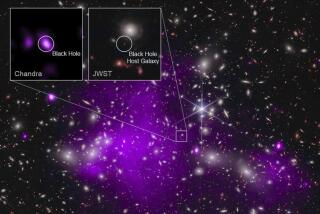Dormant Black Hole Sheds New Light on One of Space’s Mysteries
- Share via
A suspected black hole in the Milky Way galaxy has apparently become inactive, leaving scientists--including those at UC San Diego--surprised.
UCSD astrophysicist Richard Lingenfelter has been studying the so-called black hole for years. He says the recent development helps confirm the existence of a black hole, a collapsed star with gravity so strong it draws stars and other matter, including light, into its center.
As a result, black holes are invisible, and their existence must be inferred from how they affect surrounding material.
“There’s some very violent things going on out there,” he said with a chuckle. “It all has a lot to say about the nature of our universe, our galaxy. . . . I think we have important new information about what’s happening at the center of the galaxy.”
Rays Flicker On, Off
What UCSD scientists have found to bolster the black hole theory is new evidence that gamma rays flicker on and off in that region of space.
The new findings by astrophysicists from UCSD and UC Berkeley add to evidence collected over the past decade that a black hole sits at the center of the Milky Way, a vast galaxy of stars that is home to Earth and the sun.
The researchers made their findings using a gamma-ray detector carried by a remote-controlled, high-altitude balloon during a May 22 flight from Alice Springs, Australia. The balloon was built by researchers from UCSD, Berkeley and two French institutions.
Last October, a balloon-borne instrument detected intense gamma-ray emissions from the center of the Milky Way. The gamma radiation is produced when electrons and positrons (anti-electrons) collide and are annihilated.
“The flux they detected from positron annihilations at the galactic center was twice the level of the background radiation,” said James Matteson, research physicist from UCSD’s Center for Astrophysics and Space Sciences and leader of the gamma-ray project. “The flux we saw last month was half of what they saw in October. This is a very exciting finding. It’s consistent with the idea that this powerful source at the center of the galaxy does flicker on and off, and now it’s off again.”
Sucked Into Black Holes
Scientists believe gamma rays--a form of radiation--are emitted when stars and other materials are sucked into black holes, sending fundamental particles of matter slamming into each other. The rays are created by the collision of electrons--the particles that create a television picture--with their antimatter counterparts, called positrons.
The reduction in radiation from the center of the Milky Way has prompted UCSD researchers to calculate that emission of gamma rays flickers on and off as often as once every six months or so, depending on how often stars and other materials are sucked into the black hole.
Scientists first detected gamma radiation coming from the center of the Milky Way in the 1970s. But it stopped between 1979 and 1980, and researchers speculated that the radiation they had seen was a rare event.
As late as April, 1988, a California Institute of Technology flight did not detect the radiation.
But in May and October of 1988, balloons sent up by NASA’s Goddard Space Flight Center in Maryland and by AT&T; Bell Labs detected the radiation, indicating to scientists that the event occurred more frequently than believed.
“In the long run, this will improve our understanding of these very high energy processes that go on at the center of our galaxy, in the black hole,” said Lingenfelter, a theoretician who analyzes the results brought back by others, such as those who launched the balloon. “We have much more to learn, much more to find out.”






